Carbon dioxide fire extinguisher - device, principle of operation, rules of use
This article will focus on the device, principle of operation and features of using a carbon dioxide fire extinguisher. This type of fire extinguisher is the most popular today. It is easy to use, always in a visible place and it is important to know and be able to use it correctly in a critical situation, sometimes this skill can help prevent a big fire and save more than one human life.
Carbon dioxide (carbon dioxide) is used in fire extinguishers for a reason. Chosen for the role of a fire extinguisher, it allows quick and effective fire extinguishing, because immediately after the release of this composition from the fire extinguisher under pressure, the flame will disappear. In addition, the possibility of exposure in a small radius allows you to quickly eliminate local fires without significant penetration of carbon dioxide on foreign objects located near the danger zone.
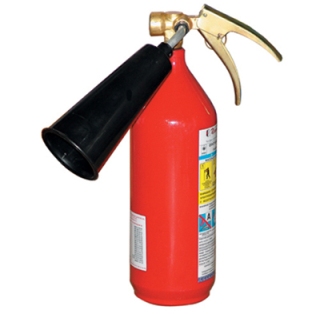
Carbon dioxide fire extinguishers (abbreviated OU) — these are fire extinguishers belonging to the gas category, since in them carbon dioxide, carbon dioxide, which is in a liquid state in a charged bottle, serves as a working medium. Being in these conditions at its own excess pressure of 5.7 to 15 MPa, it is able to explode and immediately take down the flame.
Carbon dioxide fire extinguishers are designed to effectively extinguish fires in conditions where the combustion reaction takes place with the participation of oxygen. It is also permissible to use an op-amp for extinguishing fires in electrical installations under voltage up to 1 kV or with removed voltage in electrical installations up to 10 kV.
Fire extinguishers of this type in municipal, administrative and residential premises avoid damage to high-tech and other valuable equipment, since carbon dioxide simply evaporates at the end of the extinguishing process, leaving no traces behind. From this point of view, the carbon dioxide fire extinguisher is environmentally friendly.
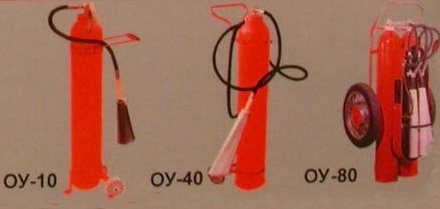
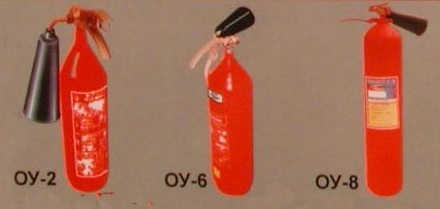
Despite the fundamentally high efficiency in the above situations, fire extinguishers of this type are not suitable for extinguishing fires where substances burn without oxygen. Such substances include aluminum, magnesium, alloys of aluminum and magnesium, potassium, sodium, as well as other compounds and materials that allow the smoldering process in their own volume. Special dry powder fire extinguishers are useful for extinguishing such situations.
The functioning of a carbon dioxide fire extinguisher is based on the process of sharp expansion of the gas volume with active absorption of heat. Approximately the same principle is used in refrigeration installations.For this reason, snow may be observed on the extinguisher mouth when very rapid cooling occurs. Because of this, the socket is often made of metal. If the bell of a fire extinguisher is not metal, but polymer, it is important to remember about the high probability of accumulation of electrostatic potential and static electricity on its surface.
During activation, avoid contact of the socket with open areas of the skin, this is fraught with thermal burns, since the temperature of the metal drops very quickly to -70 ° C.
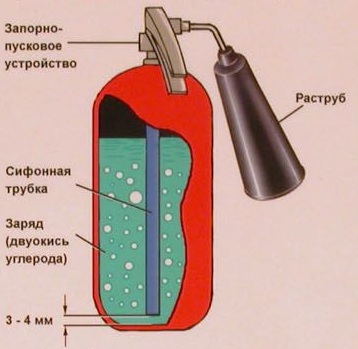
The main part of a carbon dioxide fire extinguisher is a cylinder, a high-strength metal tank into which carbon dioxide is pumped under pressure. The neck of the cylinder is fitted with a screw gun or valve actuating device which is connected to a siphon tube. This pipe descends to the very bottom of the cylinder.
The bell is firmly connected to the trigger using a metal tube or armored hose. The armored hose connection is found in portable carbon dioxide fire extinguishers that are used in flammable industries where rapid localization of a large fire source is required.
Portable models are equipped with a launch lever located on the neck, the pressure of which leads to the fact that carbon dioxide rushes through the siphon tube to the bell, where it expands sharply in volume, turning into a solid state, that is, snow.
As for the mobile models of carbon dioxide fire extinguishers, to activate them, you first need to turn the lever all the way, and the next step is to spray carbon dioxide with a gun on the hose.
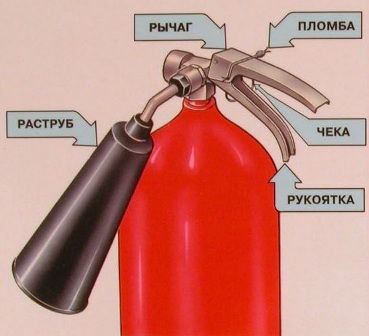
Carbon dioxide fire extinguishers should only be placed in places free of open access where they can be easily seen from a distance. The balloon is red, so there shouldn't be any problems here. In this case, it is necessary to exclude the possible impact of direct sunlight and heat from the heating system on the fire extinguisher housing.
The permissible temperature range for storage and operation of carbon dioxide fire extinguishers is from -40 ° C to + 50 ° C.
In case of fire, tear off the pin from the locking mechanism (pull the safety ring) and aim the bell at the place of fire, then press the lever.
The carbon dioxide fire extinguisher is a reusable device, it can be recharged many times on special equipment, this can be done by contacting a specialized organization. Transporting a carbon dioxide fire extinguisher is permissible in any position and with any type of transport.
Starting from the date of issue, every 5 years, the bottle must be inspected, and every two years a mandatory control of the mass of the charge is carried out. Pay attention to the date of the last survey before activating the carbon dioxide fire extinguisher, it must be indicated in the passport or on the label.
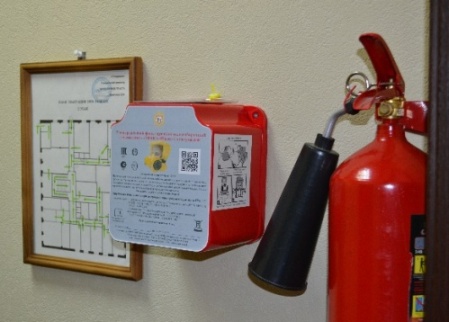
If it was necessary to use a fire extinguisher in a closed, non-ventilated room, then after extinguishing it is necessary to ventilate the room, otherwise there is a possibility of poisoning with fire extinguisher vapors.
In the process of using a fire extinguisher, the following can be observed:
-
Reduction of carbon dioxide vapor pressure in sub-zero ambient temperature conditions, which means low extinguishing efficiency;
-
Accumulation of static electricity on the non-metallic bell;
-
Significant thermal stresses due to a sudden drop in temperature in an area covered by a fire.
To avoid damage due to thermal stresses, the torch must be pointed directly into the fire. To prevent electrification of the bell, especially if the extinguisher is used in the non-sparking or low electrification mode of the facility, use only fire extinguishers with metal bells.
If using a large mobile fire extinguisher, especially in a confined space, be sure to first wear respiratory protection, at least an oxygen mask, because the rapid increase in the proportion of carbon dioxide in the surrounding air will easily lead to loss of consciousness.
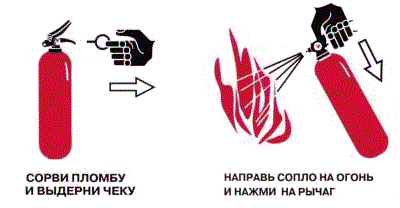
Both in industry and in everyday life, carbon dioxide fire extinguishers are the most popular today due to their efficiency and ease of use. It is also important that the carbon dioxide evaporates without causing significant damage to surrounding objects.
We hope that this material has helped the reader to understand the structure and principle of operation of a carbon dioxide fire extinguisher, as well as to understand how to use it in an emergency. In any case, you should never forget fire safety rules, and to prevent possible fires.
